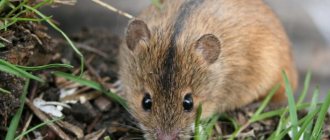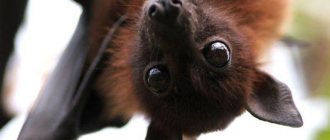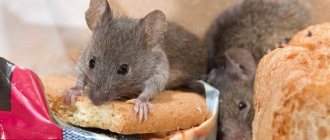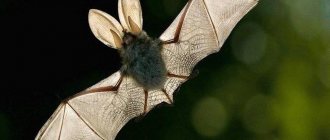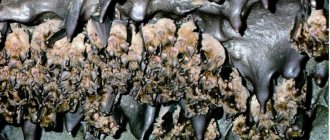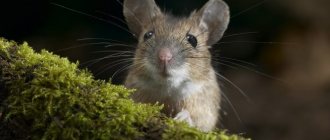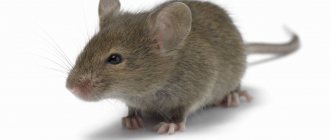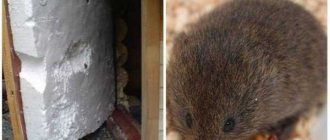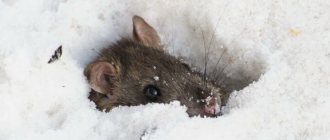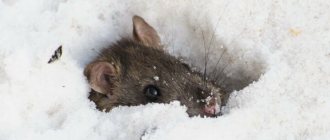- Wild animals
- >>
- Mammals
The vole mouse is a constant companion of humanity.
Due to the fact that these small animals carry many dangerous diseases and damage agricultural crops, people consider mice their enemies. At the same time, in folk art you can often find a mouse - a fairy-tale assistant, a faithful companion in business. This material is about the field mouse, a small and charming animal that plays a vital role in the functioning of ecosystems over vast territories, in a wide variety of natural conditions.
Origin of the species and description
The vole mouse, as the mammal species field mouse (Apodemus agrarius) is often called, belongs to the genus Wood and field mice, which is part of the Mouse family, which belongs to the order Rodents.
Animals are endowed with all the main characteristics of the Rodent order:
- They have upper and lower pairs of incisors that constantly grow and do not have roots;
- Consume plant foods;
- They have a long cecum;
- Early puberty;
- They have high fertility and produce several litters per year.
Distribution
Area
— Advertising —
Field mice live in Central and Eastern Europe, in the south of Western Siberia, China, Mongolia, Primorye, the Korean Peninsula and Taiwan. In western Europe, field mice live only in the eastern and central regions, west of the Baltic coast and Denmark to Finland in the north, in southern Siberia, Korea, and China. Widely distributed from the Baltic States to the coast of the Black and Azov Seas up to Sukhumi. They are found in the Ciscaucasia and western Caspian region, in Kazakhstan in the Far East.
Habitats
Rodents usually live in bushes and meadows. In anthropogenic landscapes they are found in gardens, parks, and cemeteries. The refuges of field mice are both natural shelters and holes that they dig on their own. In wet and flooded areas, rodents build nests for themselves in grass or bushes.
Appearance and features
Photo: Vole mouse
The field mouse is a relatively small animal, has an oblong body 10-13 cm long, the tail is slightly shorter and makes up up to 70% of the body length. Mice have short and stiff fur, which on the back is usually colored gray, brown or red; there are motley and striped individuals. The fur along the ridge is colored black in the form of a stripe (“belt”) running from the neck to the base of the tail. The fur on the abdomen is usually lighter, colored in gray tones.
On the pointed, blunt muzzle (2.1 - 2.9 cm in size) there are small black eyes and semicircular short ears, which determine the excellent hearing of rodents. Sensitive whiskers grow around the nose, which give mice the ability to perfectly navigate their surroundings even in the dark. Mice do not have cheek pouches, which are characteristic of many rodent species. For field mice. Unlike other representatives of the genus Apodemis, it is characterized by a special skull structure. Mice have short legs with five fingers.
Video: Vole mouse
The fingers have short claws, dulled from constant digging. The hind feet are elongated, protrude forward when moving and have a size of about 2.5 cm. The tail is long, reaching up to 9 cm, on the surface there are keratinized skin scales with sparse hairs.
Photo
Meet the vole in our photo gallery:
Also read on our website about the subspecies of the vole: root vole, gray vole, bank vole.
If you find an error, please select a piece of text and press Ctrl+Enter.
Where does the field mouse live?
Photo: Mouse vole animal
There are two large regions in the habitat of voles: European-Siberian-Kazakhstan and Far Eastern-Chinese. The first region (western) is located from Central Europe to Lake Baikal, the second region of the range is from the Amur to the Chinese Yangtze. In Transbaikalia there is a rupture of the range. The habitat of the field mouse is influenced by many factors, the most important being vegetation characteristics and the influence of human activity.
Another limiting factor in the spread of mice is humidity, so the natural habitat is areas adjacent to rivers and lakes, with wetlands, with diverse vegetation and adjacent meadows, meadow steppes, separately growing shrubs, moist edges, clearings, deciduous and mixed coniferous-deciduous forests.
The largest population is located in the forest zone of the northern part of the range, where the amount of precipitation per year is in the range of 500 – 700 mm. In forests and steppes (precipitation volume less than 500), field mice are less comfortable, so they inhabit lower, more humid forms of relief.
The size of the habitats of individual mice is enormous for such a small animal - up to several tens of thousands of square meters.
Typically, mice dig simple and shallow holes (up to 10 cm deep), of simple structure; they consist of one or two chambers with 3-4 entrance holes. In places with complex microrelief, mice can dig complex burrows up to 7 m long, in which a colony of animals settles. When living in flooded lowlands, where it is impossible to dig a hole, field mice build nests on bushes in the form of balls, adjacent to paths of grass.
Under unfavorable conditions unsuitable for existence, mice are able to migrate several kilometers. Field mice often visit landfills and garbage dumps in settlements. City conditions are favorable for the life of field mice, but they avoid human habitations. They can be found in sparsely populated parts of the city in the basements of houses and in deserted warehouses.
Sabotage
Field mice, if not controlled, cause enormous damage to agriculture. At the same time, they not only eat the crop, but also dig holes, numerous ones, causing damage to the root system of various crops.
With the arrival of winter, if mice sneak into storage areas, which is not difficult, they can destroy up to a third of the supplies. At the same time, they contaminate food products with urine and feces, making them unfit for consumption.
It is important to know! The vole mouse does not bite and at the first danger it tries to quickly hide in its shelter. But if the animal is driven into a corner, it will definitely defend itself. At the same time, we must remember that rodents can infect humans with viruses, bacteria and infections, as well as serious illnesses.
What does the vole mouse eat?
Photo: Field mouse
The vole is a typical herbivorous rodent; its incisors grow throughout its life. Appearing at the 2nd month of life of mice, they grow by 1-2 mm every day. To prevent teeth from becoming oversized, rodents must continually grind them down. To do this, animals bite inedible hard objects that surround them.
The mouse eats any available plant food:
- Fruits (berries, seeds);
- Aboveground parts of plants (leaves, stems, buds);
- Underground parts of plants (root crops, succulent roots, sweet tubers, bulbs);
- Tender young bark of broad-leaved trees and berry bushes.
Seeds predominate in the vole's diet, but field mice also eat quite a lot of green food (especially leaves and stems of plants), more than other rodents. Mice do not refuse to feast on animal food (insects, caterpillar larvae, beetles, earthworms), which is also present in the diet. They willingly consume foods (grains, cereals, legumes, flour, vegetables, fruits, baked goods, meat, lard, sausage) found in a person’s home.
In total, during the day, an adult field mouse must eat food and drink liquid in an amount equal to its own weight (5 grams of dry food and 20 ml of liquid). When there is a shortage of water, the animal gets it from the succulent parts of plants. The field mouse accumulates up to 3 kg of winter food reserves, since the little worker begins to stock up already in mid-summer. During the winter period, it eats everything that it managed to store in the hole during the warm season.
Interesting facts about the rodent:
The field mouse is considered a major agricultural pest because it eats grain crops. In winter, this type of rodent constantly stays close to grain stacks and straw sweeps. In addition, voles damage crops such as potatoes, carrots, tomatoes, watermelon, and sunflowers. The field mouse is also a natural carrier of pathogens such as tularemia, leptospirosis, tick-borne typhus fever, erysipelas, and hemorrhagic nephrosonephritis. For these reasons, people try to get rid of the proximity of these rodents, for which they use mousetraps, ultrasonic repellers, which are laid out in warehouses, and special poisons. One of the humane ways to get rid of voles is to scatter ash in the premises, which mice avoid, or to lay out heads of garlic, the smell of which field mice also cannot stand and immediately leave the room. Cats are also purchased to combat field mice.
Features of character and lifestyle
Photo: Vole mouse in nature
Field mice are fussy and voracious creatures. The mouse's body temperature ranges from 37.5°C to 39°C. In order to maintain it, animals need to be active around the clock and all year round and consume a lot of food. If a mouse stops moving in winter, it will freeze; if it stops moving in summer, it may die from excess heat. The entire life of a mouse is spent in motion - foraging for food, eating, mating games, giving birth to offspring and caring for them.
Daily activity changes throughout the year: in summer - at night, in autumn - day and night, in winter daytime activity increases. In conditions of lack of food and deteriorating living conditions, at the beginning of the cold season, mice migrate to more comfortable conditions, often approaching human habitation, and return back in the spring.
For effective protection, obtaining food and raising offspring, field mice live in groups. In a flock of mice there is a main male - the leader, who maintains order and determines the time of rest and wakefulness. Weaker individuals try to behave as quietly and unnoticed as possible; activity depends on the place the animal occupies in the structure of the group.
Female mice are calm and peaceful, while males periodically try to dislodge the leader. Dissatisfied behavior can be identified by stomping with its hind legs and harshly hitting the ground with its tail. Sometimes clashes within a group can lead to the disintegration of the pack, followed by the formation of a new one.
The burrows of individual mice are connected by treadmills, forming a settlement consisting of 20 - 40 burrows or more. In the spring, the paths go under the surface of the ground, when the grass grows and provides shelter from predators, mice use the above-ground paths. After harvesting, land movement becomes unsafe and they return underground. Large colonies with a complex network of underground and above-ground passages form in agricultural fields.
Field mice are active in winter; they hide from the cold and enemies under snow cover, moving around and using their food supplies. It should be noted that, contrary to the prevailing opinion about the cowardice of mice, the animal will protect its offspring and home even from an animal that is many times larger than itself.
Harm to humans
The mouse vole is the largest parasite that is dangerous for agriculture. They are capable of causing significant damage not only to growing plants, but also to granaries. Field mice live in grain storage facilities, barns, and in summer cottages they destroy plantings of tomatoes, carrots, cabbage, and sunflowers.
When a rodent enters the cellar, it completely destroys all winter supplies. In spring, pests feed on young shoots and bark, causing significant damage to the crop that has not yet emerged. Considering the damage caused by mice, immediately begin exterminating rodents, otherwise loss of food and plantings in the garden cannot be avoided.
Social structure and reproduction
Photo: Field mouse babies
Field mice are very fertile, like all rodents. Females reach puberty at 3 months and become capable of conceiving and giving birth to cubs. In sexually mature mice, estrus begins, which lasts 5 days and is expressed by characteristic behavior.
Males mature a little later. Mice are polygamous; in nature, a male can cover from 2 to 12 females. If the mating does not end with pregnancy, within a week the female will go into estrus again.
If fertilization is successful, after an average of 22 days, at night, the mouse gives birth. Each litter contains from 3 to 12 cubs. Naked, toothless and blind helpless mice are born, ranging in size from 2 to 3 cm.
The mouse feeds its children with milk for about a month; mouse babies grow and develop very quickly:
- on the 3rd day of life, fluff will grow on their body;
- on the 5th day the mice can hear;
- on the 7th day, the body weight of babies doubles;
- by 10 days the body is covered with full hair;
- eyes appear at 2 weeks;
- after 19 days the mice eat on their own;
- on the 25th day, the body length reaches 5 cm (the tail is shorter than that of an adult animal), the pups are able to live independently.
In a year, depending on the habitat, mice can produce from 3 to 8 litters. Reproduction of wild mice in natural conditions occurs exclusively in warm seasons. In winter, even in stacks and stacks of hay and straw, mice practically do not reproduce. Mice that live in heated human homes breed all year round.
Under favorable environmental conditions, the population grows rapidly. On average, wild field mice live from one to one and a half years. In human dwellings, some individuals live up to 7-12 years.
How to get rid of a mouse-vole
The fight against parasites consists of several points that must be combined to obtain the desired result:
- follow preventive measures that force mice to leave the territory of their summer cottage due to poor living conditions;
- use physical methods to control parasites.
Humanity has come up with many methods to combat voles, all of them can be divided into several main categories:
- time-tested folk remedies for mice;
- physical methods that involve the use of mechanical devices: traps, traps, mousetraps. This category includes the natural enemy of mice - the cat, ultrasonic repellers;
- chemicals: various aerosols, poisons, poisonous baits. Insecticides show excellent results, but are often dangerous for humans or animals living on the territory of the dacha.
When selecting the desired method against voles, take into account the characteristics of the room in which there are pests and the presence of animals.
Folk remedies and recipes
Mice have coexisted with humans for many centuries. During this period, people found out what rodents don’t like and learned to use these drugs against them. Before you start fighting parasites with chemicals, try using natural remedies that have been tested for more than one generation.
Folk recipes against voles:
- combine wheat flour, lime in equal parts, add a few pinches of salt. Place the bait in small quantities in saucers, place water nearby. After the parasite eats the “treat,” a blood clot forms in the stomach and the rodent dies. You can replace lime with gypsum, the result will be the same;
- In summer, make sure to stock up on anti-mouse herbs. They need to be placed in boxes with clothes and placed in cellars. Such herbs include: mint, wormwood, elderberry, tansy, wild rosemary. Also suitable are the roots and seeds of blackroot from mice, which is easy to find in your garden. All herbs are used in dried form, except for elderberry (use it fresh, do not put it next to food). Bundles of repellent plants are placed around the entire perimeter of the house and tied around trees;
- If you didn’t have any herbs prepared in the summer, then buy peppermint essential oil. Generously dampen a small piece of cloth with ether. Place a natural repeller in the mink, and for several days there will be no trace of mice left. In a similar way, you can use tansy, citrus, and coniferous oils.
Physical methods of destruction
Many people prefer to use proven mechanical methods, but keep in mind that you will have to regularly remove the carcasses of dead individuals. If the number of rodents is very large, then the bait may not work (the mouse may eat the bait and dodge the mousetrap). Many people prefer to have a cat, but “fluffies” live in the country with their owners only until winter. Not every cat is able to instill fear in mice; most pets themselves are afraid of rodents or simply do not want to hunt them.
Homemade traps show excellent results:
- glue mousetrap. You can use regular glue, but it is better to use a special product that emits a pleasant smell for mice and has toxic properties. Apply glue to a small cardboard, place such traps around the entire perimeter of the summer cottage, paying special attention to the cellar. To enhance effectiveness, place bait in the center of the cardboard (it is better to use bread soaked in vegetable oil, not cheese). Remove the caught mouse along with the trap, do not kill it in the house;
- mousetrap from a jar. Place bait at the bottom of a half-liter jar and grease the inside walls with butter. Place cardboard next to the jar so that the parasite can climb into the trap; he will no longer be able to get out (the edges are greased with oil). Change the bait regularly and remove mice, otherwise other parasites will not fall into the homemade trap.
Learn how to remove mold from clothes and prevent mold from reappearing on your items.
Effective means of controlling the Colorado potato beetle on the site and the rules for their use are described in this article.
Go to https://parazitam-stop.com/poleznoe/chelovek/kak-izbavitsya-ot-vshej.html and read about what lice look like on humans and how to deal with parasites.
Chemicals
Many summer residents prefer to use ready-made poisons and poisons for mice, which will certainly rid the room and protect food supplies from parasites.
Effective drugs:
- wax tablets "Storm". Place the product in boxes, holes, and drainage pipes. The tablets have a repellent effect; if a pest tastes the product, it will die within two weeks;
- universal “Granules”. They are made from natural wheat grains. The product has a cumulative effect (an infected mouse carries the poison on its paws and fur, affecting its relatives);
- glue "Musquidan". Effectively copes with voles not only in the summer cottage, but also indoors. It is recommended to apply it to cardboard and place the bait in the middle. When it gets on the glue, the mouse becomes tightly glued and quickly dies.
You can get rid of voles by populating your summer cottage with natural enemies: owls (one individual eats up to two thousand mice a year), martens, and foxes that feed exclusively on mice and voles. Weasels are capable of penetrating rodent burrows and destroying their offspring.
Natural enemies of mice and voles
Photo: Vole mouse
In nature, mice have a huge number of enemies that regulate their population. Mice are the favorite food of birds of prey. Owls, owls, eagles, hawks and other predators actively hunt mice. For example, in a year an adult owl can eat more than 1000 animals.
For many mammals (badger, wolf, fox, marten, weasel, ferret), mice are the main, often exclusive food. An adult ferret catches and eats up to 12 mice per day. The weasel is extremely dangerous for rodents, as it has a narrow body that can bend and penetrate mouse holes, destroying small cubs.
They enjoy eating voles and reptiles (snakes and large lizards), hedgehogs, and, of course, the most famous mouse hunter, the cat.
Varieties
Vole mice are distinguished depending on their habitat:
- common - found on the Eurasian continent;
- red - lives in the sultry Asian steppes;
- forest - lives in the forest-steppe regions of Eurasia and North America;
- underground - settles in local areas and in communications.
Interesting! In addition to the above species, there is a water vole. But it belongs not to mice, but to rats and inhabits the coasts of slow-flowing rivers and lakes with abundant vegetation.
Preventive recommendations
There are several ways to avoid re-infection of your summer cottage with rodents:
- burn all garden waste immediately, keep your dacha area clean, get a cat or dog (they will scare off uninvited guests with their mere presence);
- for preventive purposes, place chemicals, for example, “Storm” tablets, throughout the cellar, storage areas, and the house itself;
- Many people use glue traps all year round, protecting their country house from the invasion of parasites.
The field mouse is a dangerous rodent that can destroy a lot of crops. If a pest is detected, immediately begin combating it, using useful recommendations from specialists.
More useful tips on how to deal with mice in the following video:
Distribution of animals
This representative of the fauna is widespread in Europe. Animals can also be found in China, Mongolia, Denmark, Finland, Korea, and Taiwan. In the Russian Federation, the rodent is distributed in Primorye, Siberia, and the Urals. Often settles on the hills, climbs low into the mountains.
Found near the Black and Azov Seas. Does not like deserted forest-steppes and continuous forests. It takes root well in moist interfluves .
It prefers overgrown meadows with small depressions, collective farm fields, sunny edges of deciduous forests and, of course, vegetable gardens. It can be found in greenhouses, greenhouses, cellars, barns, abandoned utility sheds and even in residential premises.
IMPORTANT! With the onset of autumn, rodents move into stacks, haystacks, and stacks of straw.
